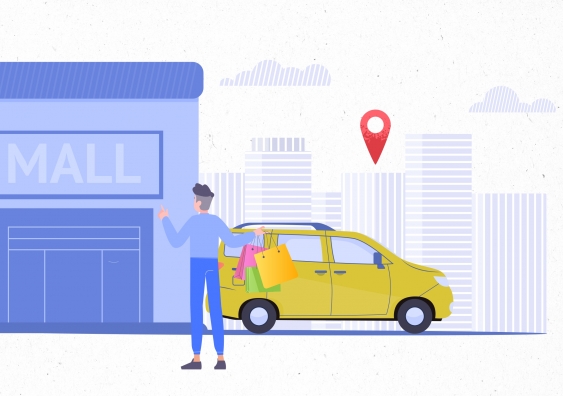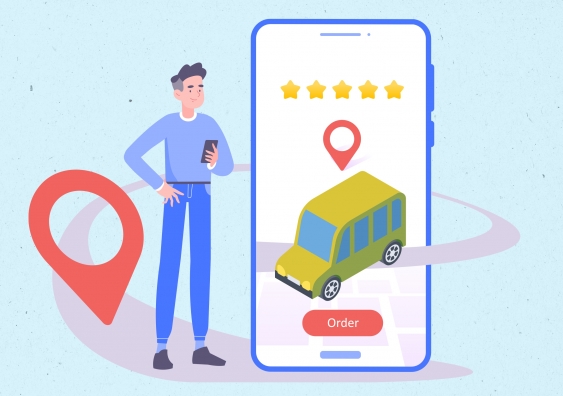Imagine being able to request a ride on public transport from your phone and have it pick you up and drop you off where you want – no more running out the door to make the bus or trying to find a park within walking distance to the train station.
Inspired by the success of rideshare services like Uber, the on-demand revolution is arriving in public transport. The idea works similarly – users can download an app and request a ride from a roaming fleet of vehicles in a designated service zone where riders determine the stops, the routes and the timetable.
In this case, the vehicle – usually a minibus or van – takes riders from their doorstep (or a convenient nearby location) to their destination along with others heading in a similar direction. Other times, it might link up commuters to major transit hubs to continue their journey to a CBD, usually for the price of a standard bus fare.
Transport expert from UNSW School of Civil & Environmental Engineering Professor Vinayak Dixit says commuters have a growing desire for more flexible and responsive travel. The UNSW Research Centre for Integrated Transport Innovation (rCITI) Director says on-demand transit could help public transport respond more to users’ needs and expectations.
“With digitisation, we now know exactly when people want to travel at the exact moment and location, which was never previously possible,” Prof. Dixit says. “Today, people want to travel when they want to, so they expect a service that meets that need. On-demand mobility is part of the solution that could help strengthen connectivity and access in our public transport system.”

An on-demand bus service can take riders from their doorstep to their destination, or fill in the gaps left by other modes of public transport. Image: Ian Joson / UNSW Sydney.
Flexible and responsive public transport
On-demand public transport could help overcome one of the limitations of regular fixed-route services – that passengers must fit into the system rather than the other way around. Also, on-demand services can better accommodate users by optimising routes on the go.
“Public transport typically operates on a fixed schedule that attempts to cater to when and where people want to travel,” Prof. Dixit says.” But it’s only an aggregate understanding that determines the frequency of those services and routes.“
As many peak-hour commuters would know, the public transport network can struggle with interconnection in areas underserviced by existing infrastructure. In situations where the distance to a designated bus stop or train station isn’t within walking distance, on-demand services can fill those gaps, Prof. Dixit says.
On-demand services would also help reduce traffic congestion and pollution by encouraging people who would otherwise drive part of their commute to leave the car at home and take public transport for the whole journey.
Read more: Pedestrians should get the green light on traffic signal prioritisation
“Many public transport service providers worldwide, including here in Australia, are already using on-demand services, and they have been shown to be effective in some locations. So it’s something we should be investigating more,” Prof. Dixit says.
According to Prof. Dixit, on-demand services may also be better than adding a new fixed bus route or running more frequent scheduled services in some places. Fixed stops are convenient for only a few people, and a timetabled bus service wouldn’t necessarily be viable for passengers making short trips.
“On-demand transit would help achieve the idea of 30-minute cities and 20-minute neighbourhoods by making movement within these areas cost-effective – one aspect of these concepts which is often overlooked in practice,” Prof. Dixit says.

On-demand mobility is part of the solution that could help strengthen connectivity and access in our public transport system, Prof. Dixit says. Image: Ian Joson / UNSW Sydney.
Getting on-demand services going
While on-demand is more flexible and responsive to users’ needs than traditional fixed-route services, don’t expect it to replace regular trains and buses anytime soon.
The uptake of on-demand services has been strong in some areas, like the Northern Beaches service in Sydney, NSW. But many other trials worldwide haven’t been as successful and have proven too costly for passengers and public transport providers.
“In places, it hasn’t worked so well as there haven’t been the right fleet sizes, zoning or operating hours, the right integration with existing transport infrastructure, or the right subsidies,” Prof. Dixit says.
On-demand services might work best linking in with more significant transport hubs rather than competing with existing public transport services, Prof. Dixit says.
“Integrating on-demand services into the existing transport infrastructure as a secondary modality, which connects users to a train station or express bus line, rather than as a major service itself, might be most effective.”
Read more: Why cycling lanes should be on the fast track for cities
But it comes down to the economics of scale and running costs, Prof. Dixit says.
“As we’ve seen, it might be suited to some places, but in others, it just might not be. That’s how we need to think about it – as one potential offering to help meet the public’s mobility needs.”
For more services to get off the ground, Prof. Dixit says they likely need subsidisation just like other modes of public transport – and the costs may reduce with uptake over time. Doing so would help improve equity within the public transport system.
“The role of public transport as an essential service is to provide affordable access to mobility, especially to those who wouldn’t otherwise have access,” Prof. Dixit says. “Affordable on-demand services, if planned right, are one offering that could help improve equitable access to mobility for all.”





